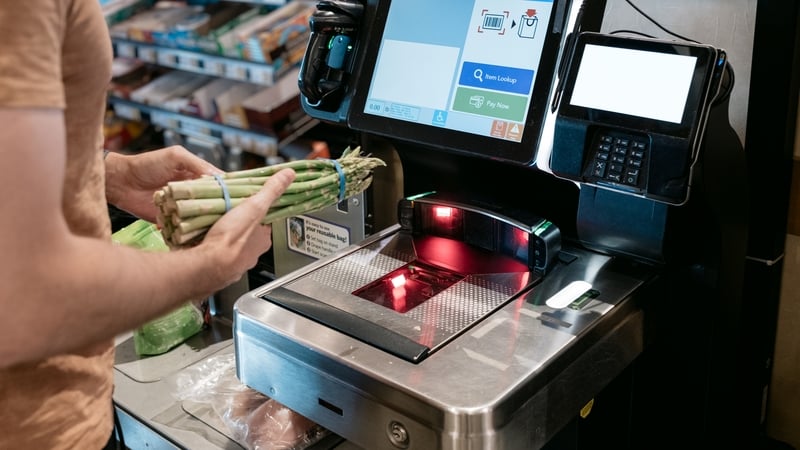Self-service shopping isn’t exactly new.
Almost 30 years ago, Superquinn introduced its ‘SuperScan’ option in some shops – allowing people to carry a scanner with them as they roamed the aisles. They could scan their goods as they put them in the trolley, and then just pay for the lot when they got to the tills.
They actually ended up abandoning that system – only to reintroduce a new version of it a few years ago.
Tesco, meanwhile, started rolling out self-service checkouts here around 20 years ago.
But while they started out as a relatively small thing in a handful of stores, now they’re a much bigger part of how their shops are set up. Today you can go into some Tescos where most of the till space is taken up by self-service machines – with just one or two manned checkouts available.
It should be said that other supermarkets have followed their lead. SuperValu and Dunnes half self-service tills in most of their branches now, as does M&S. They’re increasingly common in convenience stores like Spar and Centra, while even the German discounters Aldi and Lidl have started to roll out the format in their networks of stores recently.
But it’s not just supermarkets, is it?
No – self-service options are pretty common in major fast food chains now – allowing you to order via a touchscreen and then wait for your order number to be called.
But it’s becoming more and more common in all areas of retail now – Ikea and B&Q have self-service machines, they’re starting to pop up in a number of Zara outlets, as well as Penneys and Decathlon.
In many of those cases – just like the supermarkets – there is still the option of going to a regular checkout. But there might only be one person and a long queue, which is absolutely a conscious decision of the retailer.
So the direction of travel is clear – these shops want you to use the self-service option.
Why?
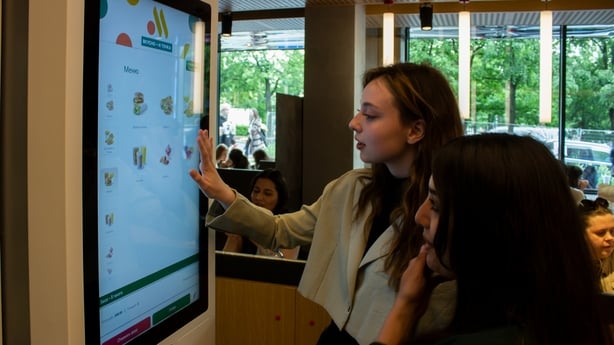
What they’ll say is that they’re meant to be quicker and more convenient – especially if you only want to buy a handful of grocery items.
Supermarkets are constantly doing consumer research and one thing that comes up time and again is that people hate having to queue for long periods of time. These machines are supposed to be part of the solution to that. But most people will raise an eyebrow at the idea that these self-service machines are more convenient, because the experience often leaves a lot to be desired.
Whatever about quicker, it certainly tends to be more frustrating than the old-fashioned checkout – between the machine not recognising a barcode, or telling you there’s an ‘unexpected item in the bagging area’, or you having to wait to get a security tag removed, or to get approval for an item from the one person who’s been tasked with managing eight or ten machines.
And of course everyone else is having these problems too, so customers are left standing around waiting for help. That means the queue is building up behind them – which kind of undermines the supposed ‘quick and convenient’ rationale of the machines in the first place.
But really it’s that staffing point that’s a big driver of the growing adoption of these machines – because retailers look at them as a way of getting one member of staff to manage the number of transactions that maybe six or eight till workers might have handled 20 years ago.
Retailers say that this isn’t about cutting staff numbers – it’s about freeing up staff to do other jobs like stacking shelves and keeping things clean. What they want to avoid is a situation where they task ten people to sit on ten tills each day, only for half of them to be idle half the time.
And they won’t say it, but shops are probably comfortable with customers getting a bit frustrated at a self-service checkout from time to time, if it means they’re getting more productivity out of their staff.
What they also won’t say is what impact the increasing use of these machines might have had on their future employment plans. Their introduction may not have prompted the companies to lay off lots of till workers, but they likely have reduced their need to hire quite so many new staff in the future than would otherwise have been the case.
And retailers are always looking more and more at ways of saving money – and ultimately reducing their reliance on staff. Sometimes that means shifting the workload onto the customer – like self-service – and sometimes it means eliminating a task altogether.
One technological advance we’re going to start seeing in Ireland in the near future are digital price displays in the aisles. They cost a lot of money to install, but once in place they allow prices to be updated at the push of a button. That ends the need for staff to be tasked with going around and swapping out paper slips one by one. Clearly retailers think it’s an investment they’ll make a return on.
And when it comes to self service tills, there’s no question that these are about saving retailers money in the long run – but they are increasingly also about finding new ways to make them more, too.
How so?
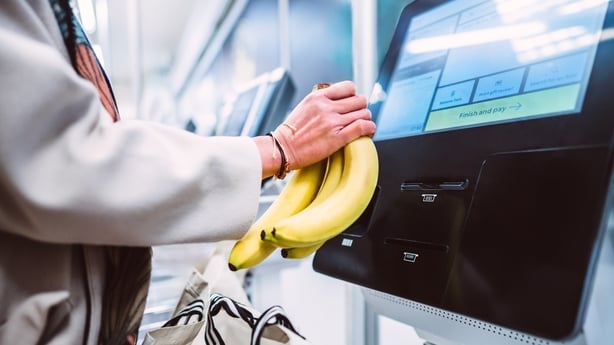
Take the example of the ‘scan as you go’ service some shops offer – where you take a scanner as you enter the shop, scan your items as you walk around, and then just pay at the till.
A prerequisite for those scanners is that you enter your rewards card or club card details upon entry – and that’s in part so they know who you are, which acts as a kind of safety net if they find that you’ve been trying to mess with the system or steal items.
But forcing you to link your personal details with your shopping habits can also create a lot of very useful data for shops – which, in theory, could end up being very valuable to them.
If you think about it, if a total stranger handed you a few months worth of their supermarket receipts you could find out a good bit about them quite quickly. Not just their favourite brands and products, but some very personal things.
For example, say you see in their receipts that they’re buying folic acid supplements – and then, after a couple of months, you notice they’ve stopped buying pads or tampons. If you were tasked with finding an offer that would encourage them to spend more money, you might think about sending them a voucher for nappies in the next little while.
Or you see they regularly buy lots of chocolate and crisps in their weekly shop – but suddenly, last week, they stopped doing that altogether – and at the same time doubled their spending on fruit and veg. In that case, there’s a good chance they’d respond well to a discount code for some low calorie snacks and treats.
And that’s the kind of value that retailers of all kinds see in your shopping data – not just so they can target you specifically, but also because they can get a picture of what different kinds of shoppers respond to.
So they might take your shopping data and bundle it together with the shopping data of 20 other people of a similar age and demographic, look at what sells well and what doesn’t, and tailor their offering based on that.
And we’re probably going to start to see this kind of thing happen in real time, too.
Last year Tesco UK announced it was going to start displaying ads in their self-scan handsets – meaning the scanners will encourage shoppers to pick up items as they walk around the shop. Those ads can be geotagged, too. That means, for example, that as you approach the chocolate aisle, you’ll get an ad for a pack of bars that’s on special offer (maybe even one that they already know you like).
Could this move to self-service be something that customers simply reject?
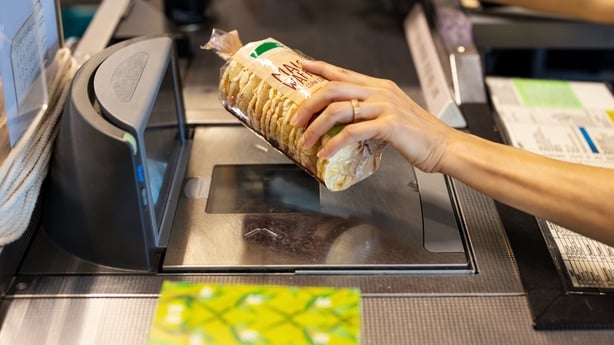
There have been calls for boycotts of shops – or the self-service queue in particular – because they are seen as a way of undermining and devaluing actual physical staff.
And there are a lot of people who will just refuse to use them at all for that reason – but they’re probably finding that harder and harder to maintain given how prevalent these machines have become.
There might be some hope, though, because last year Asda, announced that it was going to pull back from its move towards self-service tills and start having more manned tills again.
A number of major retailers in the US have done the same in recent years – opting to scale back or in some cases completely abandon their self service options.
Really, though, the genie is out of the bottle on this – and if anything we’re just going to see the self service experience become more embedded in the way shops work.
Some of that does promise to eliminate the frustration that’s involved. For example, if you go to Zara or Decathlon, you’ll notice that you don’t even have to scan the barcode – the machine detects the product through what’s called an RFID, or radio frequency identification tag. That means the tag emits a little signal that the machine picks up when it’s close enough.
Tesco has started trialling a similar system in one shop in the UK – the theory being that could you load up your basket, place it next to the till and have it detect everything that’s in there, and effectively scans it all in one go.
Tesco are also trialling a totally scan-free shopping experience, where you swipe your Clubcard as you come in the door, and then just pick up what you want and leave. The idea is that they have your credit card details linked to your account, and lots of cameras in-store to track your movement and identify the products you pick up and put in your bag.
All of that sounds very smooth and seamless – although the idea of the self-service checkout probably sounded pretty smooth and seamless before it met with the cold, harsh reality of the real world.
And bear in mind, too, that Amazon had previously opened a number of bricks and mortar shops using this technology – but ultimately abandoned the concept.
But while these kinds of advancements sound very promising – and possibly more efficient and profitable – retailers may be missing the wood for the trees in being so keen to embrace them.
In what way?
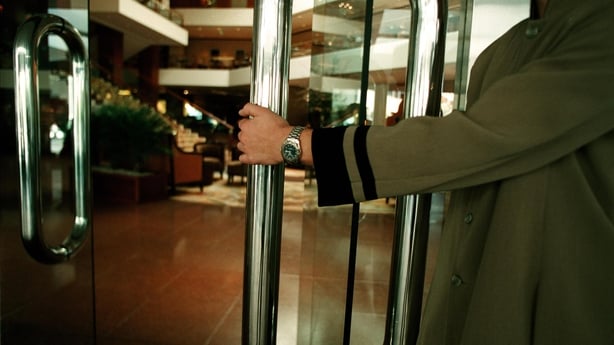
The British advertising executive Rory Sutherland has spoken before about ‘the Doorman Fallacy’ – which is about how the allure of cost savings can often trick companies into making bad decisions.
He gives the example of a high-end hotel that’s looking to cut costs – and it decides that, rather than continuing to employ a doorman, they can just invest in an automatic door that opens and closes as guests arrive and leave. And they’ll recoup the cost of that investment in no time, because of the savings from sacking the doorman.
But while that may all make sense on paper – they’re not looking at the immeasurable benefits the doorman brings to the hotel.
He doesn’t just open and close doors – he welcomes guests, he carries bags, he hails taxis, he gives directions… all of which improves the guest experience. At the same time he probably deters unsavoury characters from coming into the hotel, or hanging around outside, which is good for revenue and costs.
And I think that’s what the self service trend risks missing out on… it’s about more than just how much a manned till costs them per customer.
Some of the US brands that have reversed policy on self-service have done so because they were seeing higher levels of theft through the DIY tills, for example. So the saving they thought they were making on staff was actually getting undermined by losses on theft.
And surveys show that customers consistently value good customer experience in store – it’s one of the few things that a physical shop has as an advantage over an (often cheaper) online rival. It’s also a chance for a shop to get a customer to spend more money while they’re there, or to return in the future.
But if customers have little to no interaction with staff – and instead have to deal with annoying technology to get what they want – they might be more inclined to just go straight online the next time they’re shopping.

